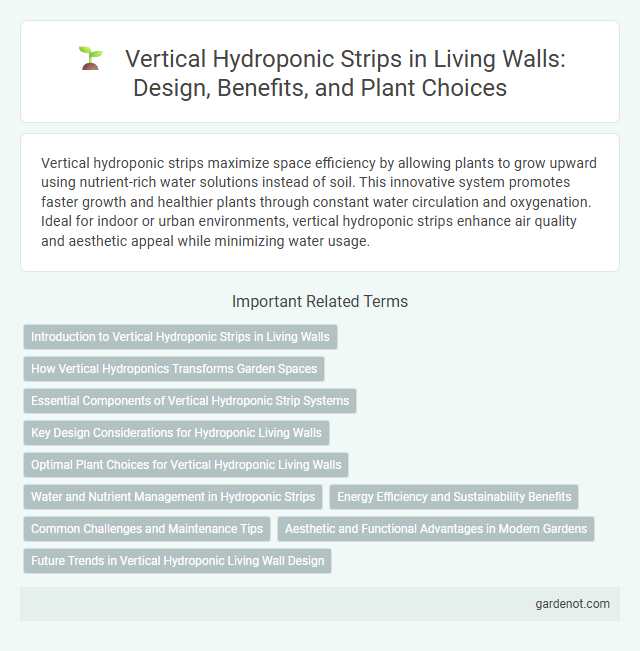Vertical hydroponic strips maximize space efficiency by allowing plants to grow upward using nutrient-rich water solutions instead of soil. This innovative system promotes faster growth and healthier plants through constant water circulation and oxygenation. Ideal for indoor or urban environments, vertical hydroponic strips enhance air quality and aesthetic appeal while minimizing water usage.
Introduction to Vertical Hydroponic Strips in Living Walls
Vertical hydroponic strips in living walls utilize soilless technology, allowing plants to grow directly on vertically mounted panels with nutrient-rich water solutions. These systems optimize space efficiency and enhance plant health by delivering precise hydration and nutrients, supporting diverse plant species in both indoor and outdoor environments. Incorporating vertical hydroponic strips promotes sustainable green architecture by reducing soil use and water consumption while improving air quality and aesthetic appeal.
How Vertical Hydroponics Transforms Garden Spaces
Vertical hydroponic strips revolutionize garden spaces by maximizing plant growth area without the need for traditional soil, enabling efficient water and nutrient delivery directly to roots. This soil-free system reduces water consumption by up to 90% compared to conventional gardening, making it ideal for urban environments and small spaces. By promoting faster growth cycles and higher yields, vertical hydroponics transforms walls into lush, sustainable green ecosystems.
Essential Components of Vertical Hydroponic Strip Systems
Vertical hydroponic strip systems integrate essential components such as nutrient delivery pipes, water reservoirs, and growth mediums to efficiently support plant cultivation in constrained spaces. Key elements include a pump or aeration system for circulating nutrient-rich water, vertical PVC or plastic strips with planting pockets for root development, and an automated timer to regulate irrigation cycles. These components work synergistically to optimize oxygenation, hydration, and nutrient absorption, promoting healthy growth and maximizing yield in vertical farming environments.
Key Design Considerations for Hydroponic Living Walls
Vertical hydroponic strips require precise control of water flow and nutrient delivery to ensure optimal plant growth in living walls. The choice of lightweight, durable materials with high water retention and proper aeration is critical for maintaining root health and preventing system clogging. Integration of modular components allows for easy maintenance and scalability, enhancing the overall efficiency and sustainability of hydroponic living walls.
Optimal Plant Choices for Vertical Hydroponic Living Walls
Optimal plant choices for vertical hydroponic living walls include leafy greens such as lettuce, spinach, and kale, which thrive in nutrient-rich, water-efficient environments. Herbs like basil, mint, and oregano also adapt well to vertical hydroponic systems, benefiting from consistent moisture and light exposure. Selecting plants with shallow root systems enhances nutrient uptake and promotes healthy, rapid growth in compact vertical setups.
Water and Nutrient Management in Hydroponic Strips
Vertical hydroponic strips optimize water and nutrient management by utilizing a closed-loop irrigation system that delivers precise amounts directly to plant roots, reducing water waste and nutrient runoff. This targeted delivery enhances nutrient uptake efficiency, promoting healthier plant growth and minimizing environmental impact. Advanced sensors and automation technologies enable continuous monitoring and adjustment of water pH and nutrient concentration, ensuring optimal conditions for diverse plant species within the living wall.
Energy Efficiency and Sustainability Benefits
Vertical hydroponic strips significantly enhance energy efficiency by reducing water usage by up to 90% compared to traditional soil-based systems, while minimizing the need for heavy machinery and artificial lighting through optimized natural light exposure. These systems promote sustainability by recycling nutrient-rich water within a closed-loop setup, drastically lowering chemical runoff and conserving valuable resources. Implementing vertical hydroponic strips in urban environments supports green building standards and contributes to reduced carbon footprints by localizing food production.
Common Challenges and Maintenance Tips
Vertical hydroponic strips often face common challenges such as nutrient imbalances, water retention issues, and root diseases due to limited soil medium. Regular monitoring of pH levels between 5.5 and 6.5, consistent nutrient solution circulation, and periodic cleaning of reservoirs help prevent buildup of algae and pathogens. Implementing proper spacing and airflow improves plant health, while routine inspection ensures early detection of blockages and system malfunctions.
Aesthetic and Functional Advantages in Modern Gardens
Vertical hydroponic strips enhance modern gardens by combining sleek design with efficient space utilization, offering vibrant greenery without soil. These systems promote healthier plant growth through controlled nutrient delivery, reducing water usage by up to 90% compared to traditional gardening methods. Their modular structure allows customizable installations that improve air quality and create visually striking, sustainable urban environments.
Future Trends in Vertical Hydroponic Living Wall Design
Vertical hydroponic strips are revolutionizing living wall design by maximizing space efficiency and enabling precise nutrient delivery for plant growth. Future trends emphasize integrating IoT sensors and automated nutrient dosing systems to optimize water use and plant health in vertical hydroponic living walls. Advances in lightweight, durable materials and modular designs will further enhance scalability and customization, making these systems more accessible for urban environments and commercial applications.
Vertical hydroponic strip Infographic

 gardenot.com
gardenot.com